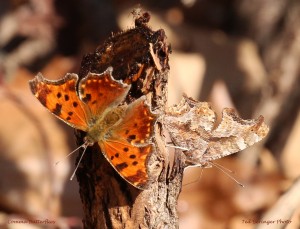Comma Butterflies
Comma Butterflies
by Ted Beringer
If you’ve been walking through the woods this early March in northeast Kansas before any leaves have appeared on the trees and long before any nectar producing flowers have begun to bloom, you might be surprised to see a butterfly. If you do, it is probably the Eastern Comma butterfly.
This butterfly has orange on the dorsal surface of both forewings and hindwings in the late winter and spring. Unlike Monarchs that migrate to this latitude only after warm weather has prompted flowers to bloom, the Comma butterfly has hibernated over the winter right here, probably under some leaf litter. Comma butterflies survive by drinking tree sap from broken branches or stumps as temperatures allow sap to flow in late winter.
There are two butterflies in this photo. Notice their scalloped wings. One butterfly has its wings spread open displaying its orange dorsal surface. The other butterfly’s wings are closed, showing only the dorsal surface decorated with an elaborate pattern of tans, browns & whites. This pattern easily camouflages the butterfly from the bark on the tree stump to which it is attached and any leaf litter around it. It is using its proboscis to drink tree sap from the stump. If you look very carefully on the underside of its hindwing, you can detect a very small white, comma-shaped mark with an expanded knob at both ends.
In the summer, Comma butterflies will also feed on rotting fruit. Nettle, wood nettle & false nettle all serve as hosts for their larvae (caterpillars).
For excellent photos of the ovum, larva (caterpillar) & pupa of the Comma butterfly visit http://en.wikipedia.org/wiki/Polygonia_c-album.



